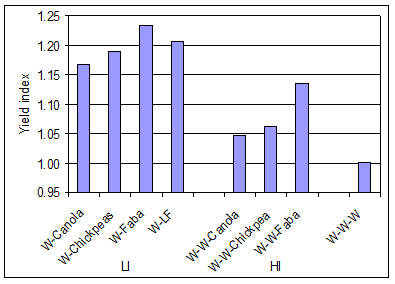Managing crown rot through crop sequencing and row placement
Managing crown rot through crop sequencing and row placement
Author: Andrew Verrell, NSW DPI | Date: 25 Jul 2014
Take home message
- Crop sequencing results in average yield gains of 17-23% over continuous wheat
- Sow break crops between standing wheat rows, which need to be kept intact
- Sow the following wheat crop directly over the row of the previous years break crop and NOT between the old rows
- This system will only work for zero tillage systems where wheat stubble is kept intact
Introduction
2005). There was a need to examine whether row placement strategies coupled with a break crop – wheat rotation, would result in differences in grain yield over a five year crop sequence.et al 2009). Crop rotation reduces the incidence and severity of crown rot resulting in yield gains of 17-23% over continuous wheat (Verrell et alInter-row sowing has been shown to reduce the impact of crown rot and increase yield, by up to 9%, in a wheat‑wheat sequence (Verrell
Experimental details
Two sequencing experiments are reported here. The first (E1) examined the effect of crop sequencing on the incidence of Fusarium pseudograminearum (Fp) and Bipolaris sorokiniana (Bs) on wheat yield. Two fully phased systems were established, with the first consisting of wheat in single phase rotation with canola, chickpea, faba bean, or wheat. The second system contained the same winter crops but commenced with a wheat-wheat phase before single phase rotations were implemented. This resulted in the establishment of either moderate (single phase = LI) or high (wheat-wheat = HI) inoculum levels of Fp prior to implementing the sequences.
The second (E2) explored the effect of crop sequencing and row placement on wheat yield.
The row placement experiment (E2) consisted of three winter sequences established in 2008 at the Tamworth Agricultural Institute (TAI);
- wheat-wheat-wheat-wheat-wheat
- wheat-chickpea-wheat-chickpea-wheat
- wheat-mustard-wheat-mustard-wheat
The TAI site consists of a brown vertosol with an average summer and winter rainfall of 400 mm and 280 mm, respectively, and soil plant available water holding capacity of 120mm to a depth of 1.0m. Durum wheat (cv. EGA Bellaroi) was sown in 2008 (40cm row spacing) and inoculated with a low level of the crown rot (CR) fungus, Fusarium pseudograminearum at a rate of 2.0 g/m row.
In 2009, wheat, mustard or chickpea was sown either on or between the 2008 wheat rows using GPS guided autosteer. In subsequent seasons crops were sown either on or between the previous year rows resulting in sixteen different row placement combinations by the time the 2012 wheat crop was sown. All crops were sown with Janke coulter-tyne-press wheel parallelograms along with 100 kg N/ha (mustard and wheat) and 10 kg P/ha (all cops).
Results
Across all cropping systems, total crop water use accounted for 49% of the year-to-year variation in wheat yield.
In E1, the continuous wheat system had the highest level of Fp (54%) and the lowest level of Bs (17%) (Figure 1). Crop sequencing is an effective break for CR with canola recording the lowest incidence of Fp (13%) (Figure 1). The use of break crops in the LI system resulted in a 17-23% yield advantage, over continuous wheat, compared to a 5-14% yield advantage for the HI system (Figure 2).

Figure 1. Crop sequence and its impact on the incidence of Fp and Bs, for different wheat (W) cropping intensity (LF = long fallow)

Figure 2. Crop rotation and its impact on wheat yield, for different wheat (W) cropping intensity. Yield indexed to continuous wheat. (LF = long fallow)
The row placement results (E2) presented here will focus solely on the mustard-wheat and chickpea-wheat systems and the last three years of the sequence trial (2010-2011-2012). Four row placement options are presented for both crop sequences and row placements are relative to the position of the 2010 wheat rows (Table 1).
Table 1. Row placement options relative to the 2010 wheat rows
|
Row |
Row Placement |
|
|
|
Sequence |
Year 2011 |
Year 2012 |
Abbreviation |
|
1 |
Between 2010 rows |
Between 2010 rows |
BB |
|
2 |
On rows 2010 rows |
Between 2010 rows |
OB |
|
3 |
On rows 2010 rows |
On rows 2010 rows |
OO |
|
4 |
Between 2010 rows |
On rows 2010 rows |
BO |
The 2012 wheat yield, in the mustard-wheat sequence, was significantly higher for the BB row option (4.46 t/ha) compared to other placements (see Table 2). Both the OB and OO options had similar yields but lower compared to BB while the worst row placement option was BO (3.84 t/ha).
Table 2. Row placement by year with grain yield, grain N removal and whiteheads for the 2012 wheat crop in a wheat-mustard-wheat sequence

NB Values within a column with the same letter are not significantly different (P<0.05)
The BO row placement sequence had significantly lower grain nitrogen removal and the highest number of whiteheads compared to the other row placement options in the mustard-wheat sequence (see Table 2).
Similar data for the mustard-wheat sequence is presented for the chickpea-wheat sequence (Table 3). In this sequence there was no difference between the BB, OB and OO row placements for the 2012 wheat yield. However, the BO sequence had significantly lower yield (4.03 t/ha) for the 2012 wheat crop compared to other options. The BO sequence also had the lowest grain nitrogen removal rate and the highest number of whiteheads (see Table 3).
Whiteheads for the wheat-wheat sequence were 2.2, 0.8, 3.5 and 1.2 (heads/m2) for the BB, OB, OO and BO row placement options, respectively.
Table 3. Row placement by year with grain yield and grain N removal for the 2012 wheat crop in a wheat-chickpea-wheat sequence

NB Values within a column with the same letter are not significantly different (P<0.05)
Summary
After five years, both break crop systems showed grain yield advantages in 2012, over continuous wheat, of 40% and 44%, for the mustard-wheat and chickpea-wheat systems, respectively. The chickpea-wheat system tended to have slightly higher wheat grain yields in 2012 for each of the four row placement strategies compared to the mustard-wheat sequence (see Table 2 and Table 3).
What this experiment has shown is that simply alternating row placement in consecutive years will not result in yield gains but a yield loss and increased CR (BO system). In the BO sequence the break crop was sown between standing cereal stubble which was kept intact. The following wheat crop was then sown between the previous years (break crop) rows but this put it directly over the old 2010 wheat row. The consequence of this sequence was that the wheat crop was sown into old infected wheat stubble hence the higher level of CR infection resulting in high whitehead counts. The benefit of the break crop in breaking any disease cycle was not realised. This is supported by the wheat-wheat whitehead data which showed higher incidence of CR for row placements where wheat was sown directly over the previous row (BB=2.5, OO=3.5) compared to between row sequences (OB=0.8, BO=1.2).
Even the traditional on row system (OO) had a better yield and CR outcome than the BO system because the break crop was sown directly over the old wheat stubble row excavating the residue out of the row (tyne with spear points) and providing a direct break to the CR fungus (see Table 2 and 3). This may not be the case however if a low disturbance disc system is used.
Based on these results the best option for row placement sequences in a break crop system is shown in Table 4.
Table 4. Proposed row placement strategy to optimise crop yield in a wheat-break crop-wheat sequence.

Following a wheat crop, the break crop (pulse or oilseed) should be sown between the standing stubble rows. In the next year, the wheat crop should be sown directly over the previous seasons break crop row. Then in the next year of the rotation the break crop should shift back and be sown between the standing wheat rows. Finally, in the fifth year, the wheat crop again should be sown directly over the previous years break crop row.
There are two simple rules that need to be followed;
- Sow break crops between standing wheat rows which need to be kept intact
- Sow the following wheat crop directly over the row of the previous years break crop
By following these two rules it ensures the following;
- Ensures four years occur between wheat crops being sown in the same row space (see Table 4)
- Substantially reduces the incidence of CR in wheat crops
- Improved germination of break crops, especially canola, not hindered by stubble
- Chickpeas will benefit from standing stubble reducing the impact of virus
- Standing wheat stubble gives better protection to break crop seedlings
Acknowledgements
Thanks to Michael Nowland and Paul Nash for their assistance in the trial program.
References
- Verrell, A.G., Simpfendorfer S., Nash P. and Moore K. (2009) Can inter-row sowing be used in continuous wheat systems to control crown rot and increase yield? 13th Annual Symposium on Precision Agriculture in Australasia (2009), UNE, Armidale.
- Verrell, A.G., Simpfendorfer S., Nash P. and Moore K. (2005) Crop rotation and its effect on crown rot, common root rot, soil water extraction and water use efficiency in wheat. Proceedings 2005 GRDC Grains Research Update, Goondiwindi.
Contact details
Dr Andrew Verrell
NSW Department Primary Industries
Ph: 0429 422 150
Email: andrew.verrell@dpi.nsw.gov.au
GRDC Project Code: DAN00116,
